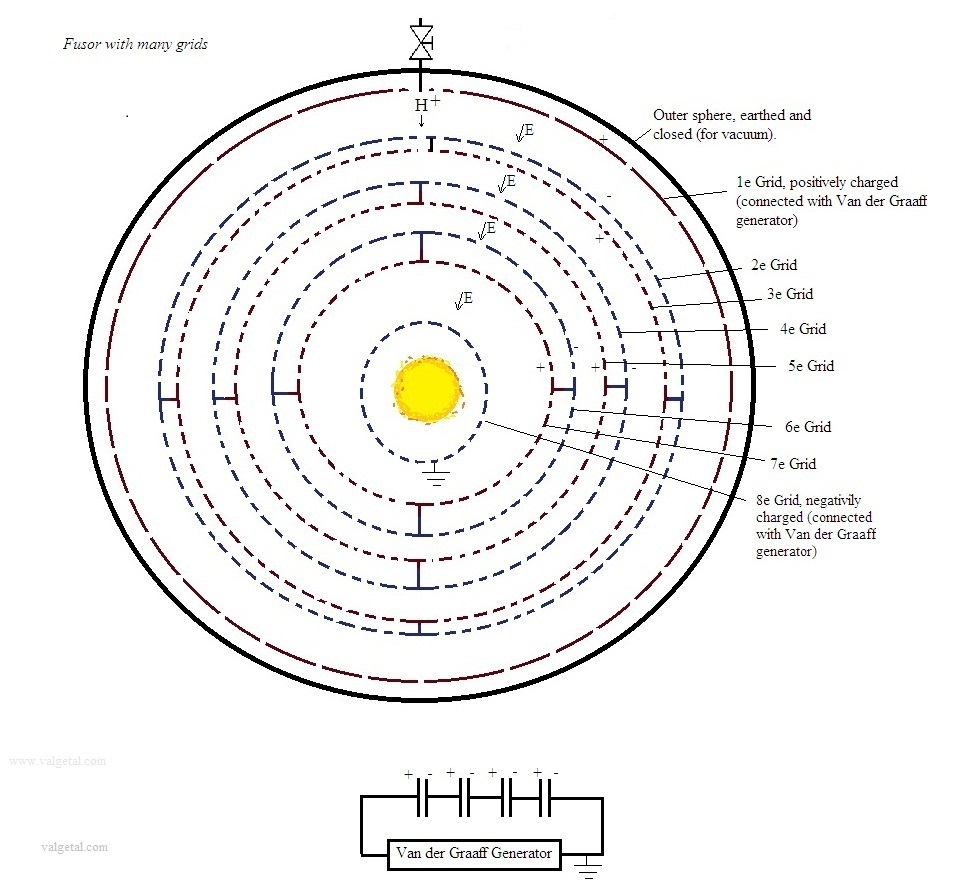 Just some ideaīs... (although not working..)
4e idea
Just some ideaīs... (although not working..)
4e idea4 Breaking the Coulomb barrier by electrostatic acceleration of ions and many grids connected like capacitors in series?
 Just some ideaīs... (although not working..)
4e idea
Just some ideaīs... (although not working..)
4e idea
Fig. 4 Fusor with many grids, each circle is a cross section of a sphere.

| With a
Van der Graaff Generator
an high voltage can be achieved. In
Van de Graaff Generator Using Cheap Parts
The outer sphere of the fusor of fig. 4 is made of, for example, stainless steel, good closed and strong to support a near vacuum inside. Inside the sphere there are many grids (in fig. 4 are drawn only 8 grids). The grids should be made of a good conducting and heat resistant metal. Perhaps (in the future) it could also be made of Graphene (very strong, thin, good conductor..). The grid must form a kind of spherical faraday cage, with as little as possible material and as much as possible empty space (holes ) to let the + ions pass. If we have a fusor with only two inner grids (a "traditional" fusor), appoximately it could (maybe?) be represented schematically as : Fig 5. Schematic
representation of a fusor with two grids
The two inner grids form by approximation a capacitor. The voltage would be about 1 MV (with a home made Van der Graaff generator). The first grid will be loaded with charge + Q, and the other grid with charge - Q (if they behave as a capacitor..), Letīs now image a fusor with 100 inner grids... Again, it could (maybe?) approximately be represented schematically as: Fig 6. Schematic
representation of a fusor connected
The first grid would be loaded by the Van der Graaff generator with a + Q charge and the last one with a - Q charge (??? here must be some error??). Now the total voltage drop would be 100 MV ??? (if the inner grids indeed behave themselves as capacitors..). An + ion traveling from the first grid to the centre of the fusor would undergo a voltage drop of 100 MV and get an kinetic energy of 100 MeV. If it would collide with the correct angle with an other +ion with about the same kinetic energy, then this would be more than enough to originate a fusion reaction.
Will this really happen? Letīs see: The first grid will get a + Q charge: the same as in the configuration with only one capacitor of fig. 5. (why would it be a different charge?). Between the 1e and 2e grid there will be (approximately) an uniform electric field perpendicular on the "surfaces" of the 2 grids. The electric field E = Q/(e0.A) for a condensator (A=surface condensator, Q= charge on one plate, e0 =vacuum permittivity). With Gaussīs Law it can be proven that outside a condensator there is no electric field. Between grid 2 and grid 3 there is not any electric field, because the two grids are connected with each other. I made an error somewhere, the voltage of the Van der Graaff Generator cannot be higher than 1 MV..... The voltage drop over each capacitor will be 1 MV /100.. but why???? The charges in grids 2 till 100 will regroup in such a way that the total voltage drop will not be more then 1 MV Itīs a pitty, but this idea will not work out......
Fig 7. Schematic
representation of a fusor connected We could also take out grid nr.100, connect the earth to grid nr. 98 and the last grid nr. 99 will be positively charged. Perhaps this is better for the behaviour of the plasma in the centre. This will neither work out... Fig 8. Schematic
representation of a fusor connected
In the configuration of fig. 8 the total volltage drop will only be 1 MV.
|